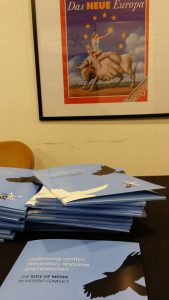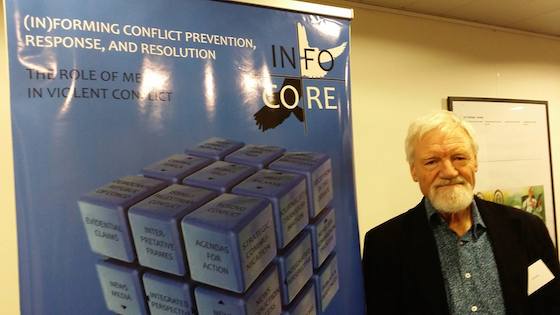Media is going through a “tremendous transformation as a result of the ever-changing, global media landscape”. Video: Euronews
By Elena Cavalione of Euronews
In a world torn apart by conflicts old and new, the issue of the media’s role seems to have growing importance.
Media coverage of atrocities committed during wars is opening up debate on the power images have to influence public opinion and political decisions.
INFOCORE is an international research study funded by the 7th European Framework Programme of the European Commission. It brings together experts from the Social Sciences to investigate the media’s role in violent conflicts in three regions: the Middle East, the Balkans and Central Africa.
Romy Frohlich from Ludwig Maaximilians University in Munich explains that journalism is under a state of tremendous transformation as a result of the ever-changing, global media landscape.
“What we see so far”, she says, “is that this change in journalism does affect or had an effect on the power balance within the shaping of public discourse, for example the relation between journalism and political actors or journalism and propaganda and public relations.”
Reporting in the Middle East
In Israel, the press enjoy very good standards of freedom, which is unique in the Middle East.
However, Palestinian and foreign journalists face military censorship and frequent abuses by both the Israeli army and Hamas in Gaza.
Since 2015, Israeli Prime Minister Netanyahu has had a grip over the communications portfolio. This gives him control over the entire media sector. He blocked a bill aimed at reforming a new broadcasting authority, fearing the new body would be critical of the government.

Digital media can guarantee more government transparency and even help change the military’s attitude towards journalists. But Professor Gadi Wolfsfed of theInterdisciplinary Center in Herzliya, says it can also undermine certain sensitive types of negotiations like peace deals.
“The positive of the fact that every citizen’s walking around with a camera”, he explains, “means that, for example, if police or soldiers are beating someone or killing them it could very well be caught on tape and uploaded onto YouTube.
“This changes the whole dynamic of the ability of the authorities to abuse people on the other side.
“However, we must be aware that there are some secrets that governments need to keep. And of course the negotiations in Oslo, that’s why it is called the Oslo peace process, were kept secret. Today it is not sure that it would be possible.
“In other words there wouldn’t have been secret negotiations because eventually something would have leaked out.”
According to the INFOCORE study, as one would expect, the Israeli and Palestinian press are extremely polarised. Hebrew language media tell their audiences one version of the facts, while the Arab media support the opposite narrative.
Meanwhile, the situation in Syria is more complex. Each side in the multifaceted civil war has set up their own media outlet.
It is almost impossible for Syrian citizens to access reliable, independent information and journalists can barely get into the country let alone report effectively on the conflict.
In this context social media have become essential for monitoring what is happening on the ground and sharing information, as Annabelle Van Den Berghe outlined: “The first sign of something going on is often on social media, is often on twitter, is often on Facebook, and it is also often on WhatsApp – she points out – I am on WhatsApp with several people inside Syria: reporters but also just civilians who are living there and updating me on the situation.
“Because WhatsApp is a bit safer than Facebook to communicate they often use that to let me know what’s happening, what is going on”.
Journalism in the Balkans
In the Balkans, foreign media played a key role in supporting the NATO interventions in Kosovo in 1999 and in Macedonia (FYROM) in 2001.
Their role was a controversial one. As with the case of the 11-week-campaign of NATO airstrikes in Kosovo in 1999, which claimed to stop the ethnic cleansing of the Albanian population from the Serbian government, and the intervention in the Former Yugoslav Republic of Macedonia (FYROM) in 2001, when Alliance troops entered the country with a mandate to disarm the Albanian rebels.
Today, the press in Kosovo face considerable financial challenges and structural problems. According to the INFOCORE study, one of the consequences of this is that journalists are not receiving appropriate training.
Abit Hoxcha, researcher at Ludwig Maximilian University in Munich told Euronews: “Journalists don’t really have proper training to report and sensitive reporting.
“Also we are dealing with a generation that has experienced war, so there is a lot of baggage attached to reporting and one of the problems we see on a daily basis in our research is that journalists carry a dose of patriotism and identity and a sense of belonging into their daily reporting.”
Kosovo is a potential candidate for EU membership. However, the European Commission report in 2016 expressed worries about the increase in attacks on journalists and the lack of transparency regarding media ownership.
In Macedonia (FYROM) press freedom is severely threatened. The INFOCORE study found that politically-controlled media are fomenting tensions between Macedonians and the Albanian minority.
Dr Snezana Trpevska, from the Institute of Communication Studies in Skopje illustrated the results of the study:
“The inter-ethnic tension in the country does not emerge only as a result of the friction between the communities themselves but also they are created from the politically manipulated media,” she says.
“So they are created from above. The discourses of conflict, of violence, of hate speech are coming from the politicians themselves who control and misuse the media to provoke tensions in order to divert the public attention from the other controversial and important issues in the society.”
People then stop relying on traditional media and go in search of alternative sources of information.
Freedom of the press in the African Great Lakes region
Ethnic conflicts, political instability and starvation typify the realities of the Great Lakes region in Africa.
In Burundi a crisis erupted in May 2015 when President Pierre Nkurunziza decided to run for a third term. More than 400 protesters were killed and 6 independent media outlets were shut down.
Currently about 80 journalists are in exile, mostly in Rwanda, and local press is controlled by the government.
Marie Soleil Frere, vice-rector at Université Libre de Bruxelles, says the situation used to be very different.
“The situation in Burundi used to be different because most of these independent registrations that were closed in May 2015 were radios that were established with the support of the international community and they were established with the aim of contributing to peace building, reconciliation, so there was a real pluralism inside of those media they would employ Hutu and Tutsi journalists and they would devote a lot of broadcasting time to programs about peace building and reconciliation.”
In the Democratic Republic of Congo independent media struggle with journalists often being threatened, attacked or arrested.
Recently, international media have also been targeted. In November 2016 Radio France International’s frequencies were suspended.
A new law making foreign media enter into partnerships with local firms was enforced.
Ernest Sagaga, from the International Federation of Journalists, believes the law aims to bring money and false credibility to the government: “They are now targeting international media broadcasters because of course they come with great credibility,” Sagaga said.
“These countries whatever they do – both Burundi and DRC- they need money to run the economies and they want to come back to their funders including the EU for the kind of assistance they get. So, there is a dichotomy if you like: on one hand they don’t want people to know what is going on in the country and on the other hand they want help or support allegedly for running the affairs of their countries.”
Neutrality, trustworthiness and independence are cornerstones to delivering reliable news reports. But according to INFOCORE’s findings, journalism could go beyond the simple reporting of facts in conflict zones.
“We can find three main kinds of journalist”, says Rosa Berganza from University Rey Juan Carlos in Madrid. “The responsible one who promotes peace and who is looking for solutions, the peacemaker journalist who specifically proposes solutions, and the watchdog role that is played by several journalists in order to account for all the violations of human rights that can be committed in different countries.”
The Pacific Media Centre is part of the 28-member INFOCORE Stakeholders Network.
INFOCORE media and conflict project
News media’s role in conflict – The Huffington Post










































